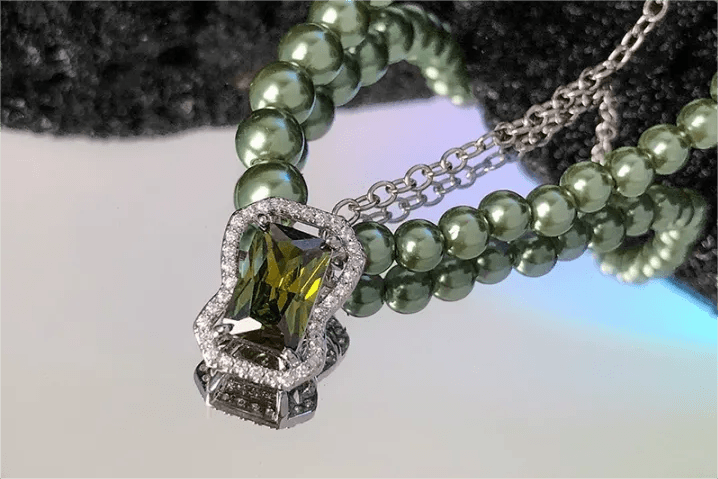May Birthstone: Gemological Characteristics of Emeralds
The green color of emeralds has been the standard by which other green gemstones are measured for thousands of years. Emerald is a rich green to blue-green beryl class, along with aquamarine and other colored beryl classes of the same mineral.
Trace elements that affect emerald color include chromium, vanadium, and iron. In general, the higher the chromium or vanadium content, the more intense the green. The higher the iron content, the bluer it is. When the iron content is relatively high, the emerald will take on a bluer green color. When the iron content is relatively low, the May birthstone will take on a purer green color.
The difference between emerald and the relatively less expensive green beryl is still debated among gem experts. Some in the industry refer to all green beryl colored with chrome as the May birthstone. However, gemologists, gemological laboratories, and most colored gemstone traders believe that it is incorrect to refer to a green beryl that is "too pale" as an emerald. There are even differences of opinion when it comes to defining the concept of "too light". GIA resolved this debate by using laboratory-graded contrasting stones to determine whether the green is dark enough and saturated enough to be called an emerald.
May birthstones are favored by gemologists for their unique inclusions. Emeralds from Colombia have fascinating and unique inclusions – known as three-phase inclusions – made up of tiny rock salt crystals, liquid and air bubbles.
May Birthstone: Emerald History and Legends
From Egyptian pharaohs to Inca emperors, emeralds have always fascinated royalty. Cleopatra loved emeralds and used them as royal jewelry. The legendary Andean crown, created in the colonies of South America, is an example of the May birthstone revered by the Spaniards. According to legend, the conquistador Francisco Pizarro took the largest emerald (now known as the Atahualpa emerald) from the last Inca emperor, Atahualpa. And the discovery of the Spanish galleon, the Nuestra Señora de Atocha (Madame Atocha), is a testament to its long history, with generations of treasure hunters bent on finding sunk trophies.
The word "emerald" comes from the ancient Greek smaragdos, which means green gem. The Roman writer Pliny the Elder (Pliny the Elder, who died in the eruption of Mount Vesuvius in AD 79) described emeralds in his encyclopedia Natural History, "There is nothing greener than it" . He also claims that the May birthstone has medicinal properties that help gem cutters: "There is no better way to relax the eyes than to gaze at emeralds, whose gentle and turquoise color soothes and relieves their fatigue and spirit. Not feeling well." Scientists have now proven this claim: Green relieves stress and eyestrain.
Emeralds are also believed to have magical powers. Put an emerald under your tongue and you can see the future. Some believe that the May birthstone protects the wearer from evil spells and cures diseases such as cholera and malaria. Others believe it can make one an eloquent speaker and expose false promises made by a lover.
According to tradition, the gemstones given on the 20th and 35th wedding anniversaries are emeralds.
May Birthstone: Origin of Emeralds
Colombia has been the source of quality emeralds for over 500 years, and Colombian emeralds are the standard against which all other emeralds are evaluated. Three mining areas in Colombia are well known: Muzo, Chivor and Cosquets. Emeralds from each mine have subtle differences in color. Each mine produces emeralds of various colors, but generally Muzo produces darker, pure green emeralds. Chivor produces weaker blue-green emeralds in a lighter shade. Cosquets, on the other hand, produces weak yellow-green emeralds.
Emeralds have also been found in Minas Gerais, Brazil. The technologically advanced Belmont Mine is one of the most prolific May birthstone mines. Another important source of emeralds is Capoeirana, a rugged region that relies heavily on independent miners and small-scale mining operations.
May birthstones can also be found in Africa. Zambia is a major producer of emeralds, and mines in the Ndola Rural Restricted Area produce emeralds that are darker and blue-green in color. Pakistan and Afghanistan are also important sources of emeralds. May Birthstone: Emerald Care and Cleaning
Emeralds have a Mohs scale of 7.5 to 8, which makes them easier to scratch than diamonds, which have a Mohs scale of 10. May birthstones are often treated to improve their color and clarity. Common treatments include:
Emeralds have some special care requirements; avoid high temperatures, changes in air pressure (such as in an airplane cabin), and harsh chemicals. Never clean emeralds in an ultrasonic cleaner. Contact with hot water used to wash dishes can also damage filled emeralds.
No matter where you are, the May birthstone is perfect for celebrating important moments in your life. Now you can gift yourself – or a loved one – an emerald for this vibrant season.
May Birthstone: Emerald Care and Cleaning
Emeralds have a Mohs scale of 7.5 to 8, which makes them easier to scratch than diamonds, which have a Mohs scale of 10. May birthstones are often treated to improve their color and clarity. Common treatments include:
Emeralds have some special care requirements; avoid high temperatures, changes in air pressure (such as in an airplane cabin), and harsh chemicals. Never clean emeralds in an ultrasonic cleaner. Contact with hot water used to wash dishes can also damage filled emeralds.
No matter where you are, the May birthstone is perfect for celebrating important moments in your life. Now you can gift yourself – or a loved one – an emerald for this vibrant season.





Leave a comment
All comments are moderated before being published.
This site is protected by hCaptcha and the hCaptcha Privacy Policy and Terms of Service apply.